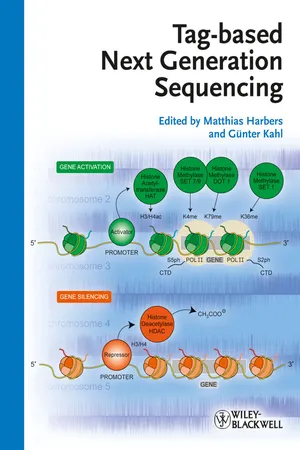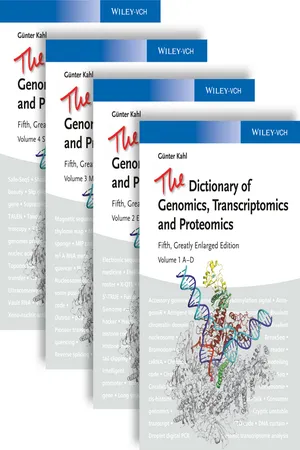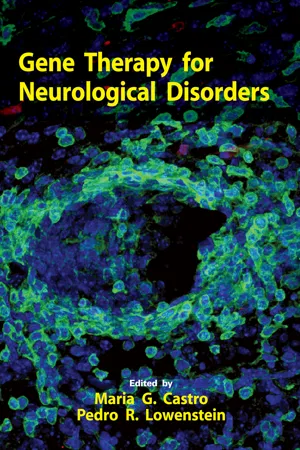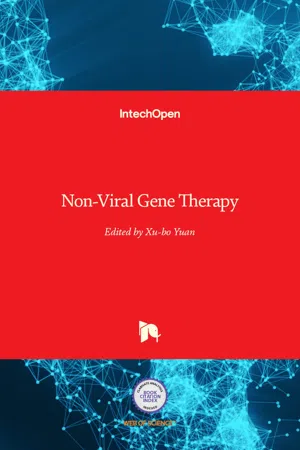Biological Sciences
Bacterial Artificial Chromosome (BAC)
A Bacterial Artificial Chromosome (BAC) is a DNA construct used to clone and manipulate large DNA fragments in bacteria. It is a vector that can carry DNA inserts of up to 300,000 base pairs, making it useful for studying and manipulating large genes or gene clusters. BACs are commonly used in genomic research and biotechnology for mapping and sequencing DNA.
Written by Perlego with AI-assistance
Related key terms
1 of 5
4 Key excerpts on "Bacterial Artificial Chromosome (BAC)"
- eBook - ePub
- Matthias Harbers, Guenter Kahl, Guenter Kahl, Matthias Harbers, Guenter Kahl, Matthias Harbers(Authors)
- 2011(Publication Date)
- Wiley-Blackwell(Publisher)
We will show that WGP is a superior physical mapping technology that can improve the accuracy of any de novo whole-genome sequencing assembly as well as for finding genetic variations in resequencing projects. 17.1 History of the Bacterial Artificial Chromosome Vector Systems Prior to the early 1970s, DNA was the most difficult cellular molecule to manipulate and analyze. However, at this time modern DNA cloning techniques were developed [1, 2] and DNA then became one of the easiest cellular molecules to work with. Despite DNA's newfound ease of manipulation researchers were still limited to cloning DNA fragments less than 30 kbp in size, because larger fragments were difficult to handle and even harder to clone. In 1987, the first large DNA fragment cloning system – the yeast artificial chromosome (YAC) – was developed [3]. This system allowed cloning of DNA fragments up to 1 Mbp, but was relatively unstable [4], had a high level of chimerism [4], and purification of cloned insert DNA was extremely difficult [5] because high levels of contamination from yeast chromosomal DNA commonly occurred. Therefore, the bacterial artificial chromosome (BAC) system (Figure 17.1) was soon developed based on the E. coli fertility (F-factor) plasmid in 1992 [6]. This new BAC cloning system effectively solved the shortcomings of the previously developed YAC system. Although using shorter inserts than YACs, BAC vectors hold much larger inserts (less than 250 kbp) when compared to cosmid/fosmid (less than 45 kbp), phage vectors (less than 25 kbp), or high-copy plasmids like pUC19 (less than 20 kbp). BAC clones are versatile tools compatible with a wide variety of sequencing applications, such as direct Sanger sequencing (i.e., primer walking) and next-generation sequencing (NGS) (454 Titanium, SOLiD, or Illumina) allowing for deep sequencing of specific regions. BAC clones are advantageous because they facilitate the cloning of complete genomes by a reasonable number of clones - Guenter Kahl(Author)
- 2015(Publication Date)
- Wiley-Blackwell(Publisher)
The BAC is composed of the E. coli plasmid pMBO 131, carrying a → chloramphenicol resistance gene, Hind III and Bam HI cloning sites, sites for → rare cutters (e.g. Bgl I, Eag I, Not I, Sfi I, Sma I), and a → bacteriophage l cos N and lox P site. Both the cos N and lox P sites provide fixed positions for specific cleavage by → l terminase. The cloning site is flanked by → SP6 and → T7 RNA polymerase promoters for the generation of RNA probes. The cloned DNA is structurally stable in the host (i.e. does not rearrange), because the low copy number of the F plasmid does not favor recombination of inserts. See → human artificial chromosome, → mammalian artificial chromosome, → pBelo Bac 11, → plant artificial chromosome, → P1 cloning vector, → Schizosaccharomyces pombe artificial chromosome, → transformation-competent artificial chromosome vector, → yeast artificial chromosome. B acterial a rtificial c hromosome vac cination (BAC-VAC) A → DNA vaccine that is composed of immunogenic DNA cloned into a → bacterial artificial chromosome (BAC) vector and elicits protective immunity in target organisms. For example, a BAC containing a replication-competent, but packaging-defective h erpes s implex v irus1 (HSV-1) genome is introduced into mammalian target cells via → particle bombardment, replicates there, expresses all 36 viral genes, and produces virus-like particles. As a result, priming of HSV-1-specific cytotoxic T cells and the production of virus-specific antibodies confers protection against intracerebral injection of wild-type HSV-1. B acterial backbone (BB) A bacterial DNA sequence, originating from a → plasmid and carrying bacterial genes such as e.g. → antibiotic resistance genes, that is part of a eukaryotic → transformation vector and therefore transferred into the recipient cell and inserted into the cell's → genome together with the → transgene(s)- eBook - PDF
- Pedro R. Lowenstein, Maria G. Castro, Pedro R. Lowenstein, Maria G. Castro(Authors)
- 2016(Publication Date)
- CRC Press(Publisher)
Long-term expression from genomic transgenes has now been demonstrated both in vitro (16) and in vivo (4,17–20). There are some unique technical challenges arising when working with genomic loci; these are outlined briefly below. Genomic DNA Clone Identification As a result of the human genome project, the identification of well characterized genomic DNA clones is quite straightforward. The strategy undertaken by the publicly funded International Human Genome Consortium involved sequencing a minimum tiling path of overlapping w 100–200 kb clones derived from human chromosomal DNA (21). These clones are all catalogued and maintained as single copy number plasmids in E. coli as either BACs or PACs (P1-based artificial chromosomes), which are able to stably carry large DNA inserts of up to 300 kb (22,23). The entire human genome sequence is, therefore, covered by series of fully sequenced BAC and PAC clones. These can be readily identified through database searches, and are freely available to the research commu-nity (24). The vast majority of genetic loci can be accommodated by a single BAC clone, and their usefulness has been demonstrated by increasing numbers of examples of gene expression from BAC and PAC clones, both in vitro (16,25) and in transgenic mice (26–28). Furthermore, every BAC and PAC plasmid includes a loxP site allowing manipulation by recombination with other loxP containing sequences (22,23). Lawler et al. 60 Handling Large DNA Inserts The use of BAC and PAC clones in gene expression studies has been hampered by their large size, which requires some specialized techniques. Fortunately, in recent years there have been advances in manipulation of large DNA by homologous recombination in bacteria, allowing easier vector construction and site-directed mutagenesis of large DNA clones (26,29–32). - eBook - PDF
- Xu-bo Yuan(Author)
- 2011(Publication Date)
- IntechOpen(Publisher)
This, along with the fact that it involves viral sequences particularly from the EBV which has been associated to several types of human malignancies (Cohen, 2000) limits the use of EBV vectors for safe gene therapy. 4.2 Human artificial chromosomes Human Artificial Chromosomes (HACs) are vectors able to replicate and segregate in parallel with the endogenous chromosomes in human cells. To achieve this, they must contain the minimal elements required for chromosome function, namely an origin of replication, telomeres and centromeres (Pérez-Luz & Díaz-Nido, 2010). One approach towards constructing HACs, called “top-down”, involves fragmentation of already existing chromosomes and generation of smaller mini-chromosomes, where only the three functional chromosomal elements remain. Several studies have shown that mini-chromosomes can host and allow the expression of large therapeutic genes, be transferred between various mouse and human cell lines and be transmitted through the mouse germ line (Kakeda et al., 2005; Shen et al., 2001; Voet et al., 2001). Though mini-chromosomes have useful properties for application in transgenics, their use in gene therapy is restricted to an ex vivo approach only. HACs with a high potential for use in in vivo gene therapy are generated by a different approach named the bottom-up. This is similar to the method applied for YAC construction in yeast and involves assembling the functional chromosomal elements and building up a HAC de novo in human cells. Different strategies have been followed to generate de novo HACs, the most convenient of which is to transfect a BAC carrying only a large array of α - Non-Viral Gene Therapy Vectors Carrying Genomic Constructs 11 satellite (alphoid) DNA and some marker genes into HT1080 cells.
Index pages curate the most relevant extracts from our library of academic textbooks. They’ve been created using an in-house natural language model (NLM), each adding context and meaning to key research topics.



